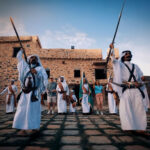Saudi Arabia’s Regional Music: Exploring the Rich Soundscapes
Saudi Arabia, a land of diverse landscapes and cultures, is also home to a rich and varied musical heritage. The music of its regions reflects the country’s deep-rooted traditions and the unique cultural identities of its people. At WithFeeling, we are dedicated to understanding and celebrating these musical traditions, working closely with local experts and musicians to bring authenticity and depth to our projects.
In this blog, we explore Saudi Arabia’s regional music, highlighting the distinct sounds, instruments, and cultural contexts that define each area. Whether you’re a music enthusiast or a cultural explorer, understanding these regional traditions offers a fascinating insight into the soul of Saudi Arabia.
Central Region (Najdi Style)
The Najdi Style of the Central Region is known for its minimalistic and introspective sound, deeply rooted in the poetic traditions of the Najd. The primary instrument, the rababah, is often accompanied by Had’u, a form of throat singing that evokes the solitude and vastness of the desert.
Instruments: The rababah stands as the central instrument in Najdi music, producing a haunting, melancholic tone that perfectly complements the austere desert landscape. The use of Had’u singing, characterized by its deep, resonant voice, adds an additional layer of introspection, making this style unique within the region.
Style: Najdi music is characterized by its steady, unadorned rhythm, which is often found in traditional styles like Samri. These rhythms, whether slow or fast, maintain a simplicity that allows the introspective and poetic qualities of the region’s music to shine through. The soundscape created is both reflective and timeless, echoing the deep cultural roots of the Najdi people.
Southern Region (Asiri-Jizani Style or Janowbi Style)
The Asiri-Jizani Style, also known as Janowbi Style, reflects the vibrant communal spirit of the Southern Region, particularly in the mountainous Asir and coastal Jizan areas. This style is rhythmic, lively, and perfect for group performances.
Instruments: Instruments like the oudah, duff, tabl, and zaar are central to this region’s musical expression. The mizmar ensemble, often referred to as oudah, is crucial in creating the vibrant, festive atmosphere characteristic of Asiri-Jizani music. These instruments are typically used in celebratory settings, where the music becomes a vital part of communal life.
Style: The music of the Southern Region is rhythmic and celebratory, often associated with cultural vibrancy and natural beauty. It is known for its group singing and dancing, with forms such as Khatwa, Mashli, and Zlaf playing integral roles in regional festivals and ceremonies. The rhythmic repetition and communal nature of this music make it a powerful expression of regional identity.
Western Region (Hejazi Style)
The Hejazi Style of the Western Region is a reflection of its cosmopolitan heritage, blending Arab, African, and Indian musical influences. This region’s music is complex and richly melodic, mirroring the diversity of its cultural influences.
Instruments: The oud, daf, and riq are traditional instruments that are central to Hejazi music. These instruments, often highlighted in forms such as Mizmar, Majas, Khubiti, and Majror, showcase the rich cultural tapestry of the Hejaz. Their use creates a sound that is both intricate and melodically complex.
Style: Hejazi music is known for its melodic complexity and rhythmic diversity, making it one of the most sophisticated musical styles in Saudi Arabia. It often incorporates elements like Ejill, Sahba, and Tarab, which contribute to its unique character. This style is a testament to the region’s rich history and its role as a cultural crossroads.
Northern Region (Shamli Style)
The Shamli Style of the Northern Region is a reflection of the nomadic lifestyle and the stark beauty of the desert. This style is vocal-centric, focusing on storytelling and themes of survival and travel.
Instruments: The rababah and frame drum are the primary instruments in Shamli music, supporting the vocal-centric nature of the style. Additionally, Daha, a throat singing style characterized by its roar-like voice, adds a raw, evocative quality to the music. Other styles such as Hegini and Refyahyi introduce rhythmic elements that enhance the narrative focus of this music.
Style: Shamli music emphasizes storytelling through its vocals, often reflecting the challenges and beauty of nomadic life. The use of rhythmic styles like Daha and Hegini adds depth to the narrative, creating a sound that is both sparse and evocative, perfectly capturing the essence of the Northern Region.
Eastern Region (Shargawi Style)
The Shargawi Style of the Eastern Region is known for its lively, rhythmic music, ideal for communal dances and celebrations. The music reflects the region’s coastal and maritime heritage, with a strong emphasis on rhythm and energy.
Instruments: Tabl and tanbur are the primary instruments in Shargawi music, creating the driving rhythms that define this style. The music also often features the call of the Nah’am and a responsive chorus, elements that are essential to both marine and land-based singing traditions in this region.
Style: Shargawi music is characterized by its repetitive, catchy melodies designed for communal celebration and dance. The call-and-response vocal patterns, along with rhythmic clubbing, are key elements of this style, making it perfect for festive occasions. This music encapsulates the lively spirit of the Eastern Region and its deep connection to the sea.
Wrapping Up
Saudi Arabia’s regional music offers a rich and diverse sonic landscape that is as varied as the country’s geography. At WithFeeling, we are dedicated to understanding and incorporating these musical traditions into our work, ensuring that each project resonates with cultural authenticity and respect. Whether you are looking to explore the introspective tones of Najdi music or the vibrant rhythms of the Asiri-Jizani style, Saudi Arabia’s regional music offers a wealth of inspiration.

















